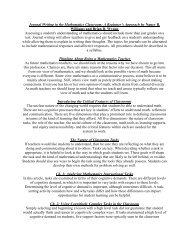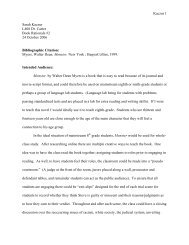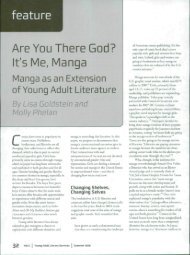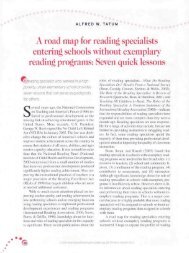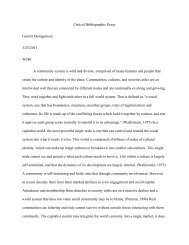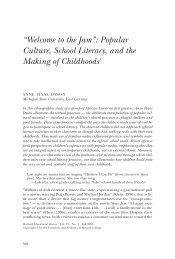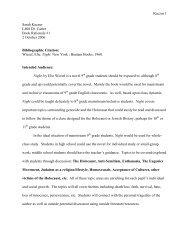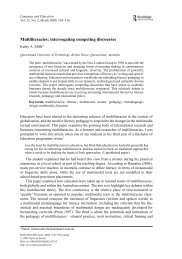Grauerholz 2003 Assessing critical thinking sociology.pdf - Oncourse
Grauerholz 2003 Assessing critical thinking sociology.pdf - Oncourse
Grauerholz 2003 Assessing critical thinking sociology.pdf - Oncourse
- No tags were found...
Create successful ePaper yourself
Turn your PDF publications into a flip-book with our unique Google optimized e-Paper software.
486 TEACHING SOCIOLOGYlearning names for the world's objects anddeveloping problem-solving skills. (Goldsmidand Wilson 1980:78)...the ability to create logical arguments basedon the "sociological imagination." (Green andKlug 1990:462)...the process of reasonably deciding what todo and/or believe. (Dorn, cited in Green andKlug 1990:465)the development of "deep professional competenceand sophisticated ethical judgment."(Nelson 1999:175)...identification of ambiguity and its role inreasoning,...discovery of assumptions andvalue conflicts,... evaluation of evidence,...assessmentof logic,...examination ofmetaphorical allusions,...identification of significantomitted information, ...generating alternativeinferences, and...development of areasoned judgment. (Browne and Litwin1987:384)...active <strong>critical</strong> and creative inquiry".(Shepelak, Curry-Jackson, and Moore1992:19)Others simply bypass the question of defining<strong>critical</strong> <strong>thinking</strong> altogether while claimingto have found ways to enhance "it"(e.g. Zeller 1988).Several scholars have attempted to synthesizethe literature on <strong>critical</strong> <strong>thinking</strong>. Ruminskiand Hanks (1995:5) suggest thatdespite disagreement over how <strong>critical</strong><strong>thinking</strong> should be defined, most expertsagree that "<strong>critical</strong> <strong>thinking</strong> includes skillsin applying, analyzing, and evaluating information."In his review of the literatureon <strong>critical</strong> <strong>thinking</strong>, Baker (1981:328) suggeststhat <strong>critical</strong> <strong>thinking</strong> is usually conceptualizedin two ways: as a "problem-solvingprocess" and as a process of "deductivelogic and argument analysis." Similarly,Dorn (cited in Green and Klug 1990) suggeststhat <strong>critical</strong> <strong>thinking</strong> involves microlevelintellectual abilities and skills, such asthe ability to clarify issues and identifyvalue assumptions; macro-level dispositions,such as a predisposition to ask forevidence or to be creative; and macro-levelvalues, such as a commitment to fairness.Geertsen (<strong>2003</strong>a) reviews various ways inwhich <strong>critical</strong> <strong>thinking</strong> has been conceptualizeddating back to John Dewey. Similar toDewey, he distinguishes between <strong>critical</strong><strong>thinking</strong>, which involves more confirmatoryprocesses such as corroborating evidenceand narrowing perspectives, and reflective<strong>thinking</strong>, which involves a broadening ofperspectives. Geertsen (<strong>2003</strong>a) suggests that<strong>critical</strong> <strong>thinking</strong> and reflective <strong>thinking</strong>, intheir many forms, represent higher-level<strong>thinking</strong>: "I believe the appropriate umbrellaterm for all types of extraordinary<strong>thinking</strong> is higher-level <strong>thinking</strong>" (p. 8).Geertsen (<strong>2003</strong>a) further identifies sixdimensions of higher-level <strong>thinking</strong>, each ofwhich involves both <strong>critical</strong> and reflective<strong>thinking</strong>. For example, one dimension ofhigher-level <strong>thinking</strong> is strategic <strong>thinking</strong>(<strong>thinking</strong> that is oriented toward application),which includes decision-making(<strong>critical</strong> <strong>thinking</strong>) and problem solving(reflective <strong>thinking</strong>).Although educators are likely to welcomeall forms of higher-level <strong>thinking</strong> in theirstudents, Geertsen (<strong>2003</strong>a) suggests thatcertain types of higher-level <strong>thinking</strong> aremore important to different disciplines.Medical professionals, for example, need tobe proficient in strategic <strong>thinking</strong>; that is,decision making and problem solving:Doctors are expected to understand and useestablished procedures for diagnosing andtreating unambiguous diseases; if they do not,a malpractice suit is likely to follow. In otherwords, they must make correct decisionswithin the parameters of established medicalknowledge. However, problem solving comesinto play when doctors encounter symptomsthat do not respond well to existing treatments.This ambiguity calls for a consideration of abroaderange of possibilities (Geertsen <strong>2003</strong>a:11).Although many scholars argue that <strong>critical</strong><strong>thinking</strong> involves abilities and skills that canbe applied to any problem or subject matter(e.g., Paul 1993; Wade and Tavris 1993),



